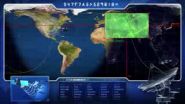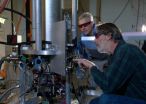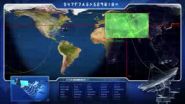(Press-News.org) The U.S. Department of Commerce's National Institute of Standards and Technology (NIST) has officially launched a new atomic clock, called NIST-F2, to serve as a new U.S. civilian time and frequency standard, along with the current NIST-F1 standard.
NIST-F2 would neither gain nor lose one second in about 300 million years, making it about three times as accurate as NIST-F1, which has served as the standard since 1999. Both clocks use a "fountain" of cesium atoms to determine the exact length of a second.
NIST scientists recently reported the first official performance data for NIST-F2,* which has been under development for a decade, to the International Bureau of Weights and Measures (BIPM), located near Paris, France. That agency collates data from atomic clocks around the world to produce Coordinated Universal Time (UTC), the international standard of time. According to BIPM data, NIST-F2 is now the world's most accurate time standard.**
NIST-F2 is the latest in a series of cesium-based atomic clocks developed by NIST since the 1950s. In its role as the U.S. measurement authority, NIST strives to advance atomic timekeeping, which is part of the basic infrastructure of modern society. Many everyday technologies, such as cellular telephones, Global Positioning System (GPS) satellite receivers, and the electric power grid, rely on the high accuracy of atomic clocks. Historically, improved timekeeping has consistently led to technology improvements and innovation.
"If we've learned anything in the last 60 years of building atomic clocks, we've learned that every time we build a better clock, somebody comes up with a use for it that you couldn't have foreseen," says NIST physicist Steven Jefferts, lead designer of NIST-F2.
For now, NIST plans to simultaneously operate both NIST-F1 and NIST-F2. Long-term comparisons of the two clocks will help NIST scientists continue to improve both clocks as they serve as U.S. standards for civilian time. The U.S. Naval Observatory maintains military time standards.
Both NIST-F1 and NIST-F2 measure the frequency of a particular transition in the cesium atom—which is 9,192,631,770 vibrations per second, and is used to define the second, the international (SI) unit of time. The key operational difference is that F1 operates near room temperature (about 27 ºC or 80 ºF) whereas the atoms in F2 are shielded within a much colder environment (at minus 193 ºC, or minus 316 ºF). This cooling dramatically lowers the background radiation and thus reduces some of the very small measurement errors that must be corrected in NIST-F1. (See backgrounder on clock operation and accompanying animation of NIST-F2 at http://www.nist.gov/pml/div688/how-nist-f2-works.cfm)
VIDEO:
A new atomic clock based on a 'fountain' of cesium atoms is to serve as the next US civilian time standard. NIST-F2 would neither gain nor lose one second in...
Click here for more information.
Primary standards such as NIST-F1 and NIST-F2 are operated for periods of a few weeks several times each year to calibrate NIST timescales, collections of stable commercial clocks such as hydrogen masers used to keep time and establish the official time of day. NIST clocks also contribute to UTC. Technically, both F1 and F2 are frequency standards, meaning they are used to measure the size of the SI second and calibrate the "ticks" of other clocks. (Time and frequency are inversely related.)
NIST provides a broad range of timing and synchronization measurement services to meet a wide variety of customer needs. NIST official time is used to time-stamp hundreds of billions of dollars in U.S. financial transactions each working day, for example. NIST time is also disseminated to industry and the public through the Internet Time Service, which as of early 2014 received about 8 billion automated requests per day to synchronize clocks in computers and network devices; and NIST radio broadcasts, which update an estimated 50 million watches and other clocks daily.
At the request of the Italian standards organization, NIST fabricated many duplicate components for a second version of NIST-F2, known as IT-CsF2 to be operated by Istituto Nazionale di Ricerca Metrologica (INRIM), NIST's counterpart in Turin, Italy. Two co-authors from Italy contributed to the new report on NIST-F2.
The cesium clock era officially dates back to 1967, when the second was defined based on vibrations of the cesium atom. Cesium clocks have improved substantially since that time and are likely to improve a bit more. But clocks that operate at microwave frequencies such as those based on cesium or other atoms are likely approaching their ultimate performance limits because of the relatively low frequencies of microwaves. In the future, better performance will likely be achieved with clocks based on atoms that switch energy levels at much higher frequencies in or near the visible part of the electromagnetic spectrum. These optical atomic clocks divide time into smaller units and could lead to time standards more than 100 times more accurate than today's cesium standards. Higher frequency is one of a variety of factors that enables improved precision and accuracy.
INFORMATION:
* T.P. Heavner, E.A. Donley, F. Levi, G. Costanzo, T.E. Parker, J.H. Shirley, N. Ashby, S.E. Barlow and S.R. Jefferts. First Accuracy Evaluation of NIST-F2. Metrologia. Forthcoming. See http://iopscience.iop.org/0026-1394/page/Forthcoming%20articles.
** These data are reported monthly in BIPM's Circular T, available online at http://www.bipm.org/jsp/en/TimeFtp.jsp?TypePub=publication#nohref. NIST-F2 is scheduled to be listed for the first time in the March 2014 edition. The value of interest is Type B (systematic) uncertainty.
NIST launches a new US time standard: NIST-F2 atomic clock
2014-04-03
ELSE PRESS RELEASES FROM THIS DATE:
Taming a poison: Saving plants from cyanide with carbon dioxide
2014-04-03
The scientific world is one step closer to understanding how nature uses carbon-capture to tame poisons, thanks to a recent discovery of cyanoformate by researchers at Saint Mary's University (Halifax, Canada) and the University of Jyväskylä (Finland). This simple ion — which is formed when cyanide bonds to carbon dioxide — is a by-product of the fruit-ripening process that has evaded detection for decades.
Chemists have long understood the roles presence of cyanide (CN−) and carbon dioxide (CO2) in fruit ripening, but have always observed them independently. This ...
Hot mantle drives elevation, volcanism along mid-ocean ridges
2014-04-03
PROVIDENCE, R.I. [Brown University] — Scientists have shown that temperature differences deep within Earth's mantle control the elevation and volcanic activity along mid-ocean ridges, the colossal mountain ranges that line the ocean floor. The findings, published April 4 in the journal Science, shed new light on how temperature in the depths of the mantle influences the contours of the Earth's crust.
Mid-ocean ridges form at the boundaries between tectonic plates, circling the globe like seams on a baseball. As the plates move apart, magma from deep within the Earth rises ...
HIV vaccine research must consider various immune responses
2014-04-03
WHAT:Last year, the National Institute of Allergy and Infectious Diseases (NIAID), part of the National Institutes of Health, held a scientific meeting to examine why certain investigational HIV vaccines may have increased susceptibility to HIV infection. In a new perspectives article appearing in the journal Science, HIV research leaders from NIAID (Anthony S. Fauci, M.D., and Carl W. Dieffenbach, Ph.D.) and its grantees at Emory University (Eric Hunter, Ph.D.) and the University of California, San Francisco (Susan Buchbinder, M.D.), summarize the findings and considerations ...
Moving the fence posts
2014-04-03
The use of fenced areas to protect threatened species in the wild should be a last resort, argue scientists from the Zoological Society of London (ZSL) and the Wildlife Conservation Society (WCS).
In an article published in the journal Science, the authors state that there is a need to review the use of fencing as the conservation community develops a clearer understanding of the ecological changes caused when an area is fenced.
Fencing can have a disruptive impact on predator-prey dynamics, with species such as the African wild dog learning to chase prey into fences. ...
Researchers design trees that make it easier to produce paper
2014-04-03
Researchers have genetically engineered trees that will be easier to break down to produce paper and biofuel, a breakthrough that will mean using fewer chemicals, less energy and creating fewer environmental pollutants.
"One of the largest impediments for the pulp and paper industry as well as the emerging biofuel industry is a polymer found in wood known as lignin," says Shawn Mansfield, a professor of Wood Science at the University of British Columbia.
Lignin makes up a substantial portion of the cell wall of most plants and is a processing impediment for pulp, ...
Cassini reports sub-surface ocean on Enceladus
2014-04-03
Enceladus—one of Saturn's smaller satellites—has joined the ranks of Titan and Europa as a moon that appears to have liquid water splashing around inside of it, researchers say. New gravity data from the Cassini spacecraft, which has been exploring the planet's moons for 10 years, reveal that Enceladus harbors an ocean of water beneath 18 to 24 miles (30 to 40 kilometers) of ice at its surface.
A team of Italian and American scientists led by Luciano Iess at Sapienza Università di Roma in Rome, Italy investigated the moon's gravity field and the notable asymmetry it ...
Gravity measurements confirm subsurface ocean on Enceladus
2014-04-03
In 2005, NASA's Cassini spacecraft sent pictures back to Earth depicting an icy Saturnian moon spewing water vapor and ice from fractures, known as "tiger stripes," in its frozen surface. It was big news that tiny Enceladus—a mere 500 kilometers in diameter—was such an active place. Since then, scientists have hypothesized that a large reservoir of water lies beneath that icy surface, possibly fueling the plumes. Now, using gravity measurements collected by Cassini, scientists have confirmed that Enceladus does in fact harbor a large subsurface ocean near its south pole, ...
'Unzipping' poplars' biofuel potential
2014-04-03
EAST LANSING, Mich. — What began 20 years ago as an innovation to improve paper industry processes and dairy forage digestibility may now open the door to a much more energy- and cost-efficient way to convert biomass into fuel.
The research, which appears in the current issue of Science, focuses on enhancing poplar trees so they can break down easier and thus improving their viability as a biofuel. The long-term efforts and teamwork involved to find this solution can be described as a rare, top-down approach to engineering plants for digestibility, said Curtis Wilkerson, ...
Study shows more than half of high-risk alcohol users report improvement after surgery
2014-04-03
BOSTON – Much has been reported about the potential for increased risk of alcohol misuse after weight loss surgery (WLS), with most theories pointing to lower alcohol tolerance and a longer time to return to a sober state after surgery, but a new study from Beth Israel Deaconess Medical Center suggests that upwards of half of high-risk drinkers are actually less likely to report high-risk drinking behavior after weight loss surgery.
The results appear in the journal, Surgery for Obesity and Related Diseases.
"This is the first study to show that high-risk drinking ...
Aging workforce requires new strategies for employee retention, MU researcher says
2014-04-03
COLUMBIA, Mo. – As more baby boomers reach retirement age, state governments face the likelihood of higher workforce turnover. For example, in the state of Missouri, more than 25 percent of all active state employees will be eligible to retire by 2016. Such large numbers of retirees threaten the continuity, membership and institutional histories of the state government workforce, according to Angela Curl, assistant professor in the University of Missouri School of Social Work. In a case study of the state of Missouri's Deferred Retirement Option Provision (BackDROP), Curl ...




